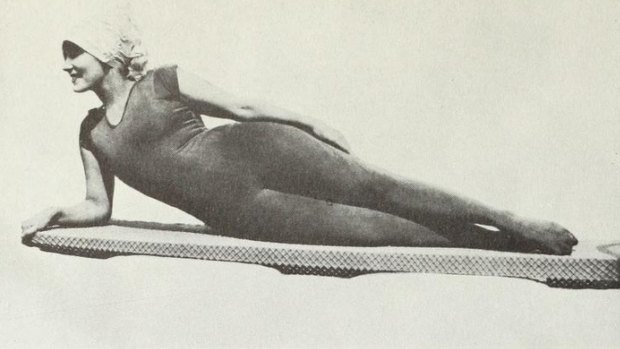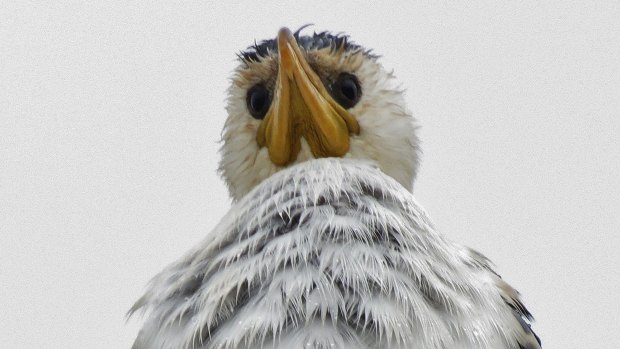By Ian Warden
If you're not hearing so much maniacal laughter in your neighbourhood these days it may be that your neighbourhood is (at last) attracting a saner kind of person.
Or, it may be that this crazed cackling was always supplied not by people but by laughing kookaburras and that there are fewer and fewer of them around to do any suburban chortling.

Annette Kellerman, The Perfect Woman
To digress a teensy bit, today's column is about human sightings of birds but of course birds make sightings of us, coming to conclusions we can only guess at. Often magpies, looking at us, cock their heads to one side the way our psychiatrists and aromatherapists do when trying to diagnose what makes us tick. In our picture one of Canberra's little pied cormorants is looking down on photographer John Bundock, assessing him.
BirdLife Australia's just-released report, The State of Australia's Birds 2015 looks at all of Australia.

A little pied cormorant looks down on our species. Credit: John Bundock
Yet of course this being a parochial little column our ears have pricked up at some of its findings about the state of Australia's birds in our region. For the report's purposes 'our region' is the enormous one, holding the little ACT in its vast embrace, of the East Coast. Of this region the report points to a sustained decline in sightings of some "common" bird species including some, notably magpies, laughing kookaburras and willy wagtails, Canberrans may believe they're still seeing a superabundance of.
"Most surprising," BirdLife Australia CEO Paul Sullivan laments, "is that we've known for some time that many rare bird populations are declining, but we were not aware of the decline of these very common and iconic Australian birds. This data is a wake-up call."
We tried in vain on Wednesday to contact the Canberra ornithologists we needed to give us an expert opinion on the ACT state of things. No doubt they were all out birdwatching. When they come home we will report what they tell us.
Meanwhile, we put some probing, parochial, sceptical questions to BirdLife Australia's head of research James O'Connor.

We wondered if enough of the vast region's sites where "citizen scientists" have gathered the report's data are in the ACT for the findings to be ACT relevant. Then, while we were being irritating, we suggested that records of "sightings" do seem a wobbly way of coming to firm conclusions about bird numbers. Common people are notoriously muddle-headed about what they think they've seen. Some couldn't tell a cockatoo from a pterodactyl.
O'Connor agrees that, yes, the defined region is huge "and very complex" but says that lots of the citizen-science data-gathering has gone on in and around Canberra. Local findings create "a huge heat area" on a map used to show hot spots of this research. Our area glows like anything.
And he fancies that however "counter-intuitive" findings of declines might seem to Canberrans (who fancy they see these common birds everywhere) he's sure the findings are, though not infallible, "very robust results".
But of course, he concedes, in so big and diverse a region there are bound to places big and small where abundances and scarcities are not average. But meanwhile, we agreed, locals need to be alert to the possibility that an abundance of a species in their neighbourhood (this reporter is temporarily blessed with visits of what are either two dozen yellow-tailed black cockatoos or two dozen pterodactyls to his nondescript Garran street) probably tell us nothing at all about how the species is faring in the wider Australia.
He says that the "citizen-scientists" doing the monitoring are not (as I said I feared) muddle-headed enthusiasts who might misunderstand what they see, not being able to tell a cockatoo from a pterodactyl. They are select, well-informed souls who use a rigorous, standardised, professionally devised methodology. What's more, he advises, when BirdLife receives reports of "anomalous" sightings "we ring up the observers and really annoy them [by asking searching questions]".
It may be, he admits, that if Canberrans here on this island (the ACT) believe we are well-blessed with kookaburras that we may be right. But he's sure that in the region as a whole a decline in numbers of some hollow-nesting species (including kookaburras) is real. It may reflect a creeping loss (often to expanding suburbia) of the old trees these species need.
We teased him a little with the report's surely wobbly finding, based on sightings, that one of the species in decline is the tawny frogmouth. Previously reported to be rarely seen it is now thought to be even more rarely seen.
But largely nocturnal, the species is by day one of the most exquisitely camouflaged creatures on earth. This reporter has "sighted" two by daylight this year but only by being in the company of groups of hawk-eyed (pun intended) birdos with lots of pairs of eyes between us. Surely those who go out bird watching look at some tawny frogmouths but without seeing them. Meanwhile they, motionless, disguised as dead wood, but all-seeing, see our species and perhaps put those sightings into a virtual database of their own.
O'Connor conceded that, yes, the collecting of data about nocturnal birds (boobook owls are another species the worrywart report agonises over) is fraught with difficulties. He agrees that it will be right to probe this data and sometimes to "come back" to it to re-examine it.
Overall, though he's sure that the report is "telling an interesting story and will be the start of a long conversation with the birdos of the region".
To download a copy of the report, go to http://birdlife.org.au/-1/state-of-birds/
100 Years Ago. 'Hope for the hopelessly fat and despairingly thin'
In a famous poster for her Hollywood silent epic film Neptune's Daughter (1914) Annette Kellerman was billed as "The Perfect Woman." All of her perfect measurements, even of her perfect forearm (9.4 inches) were detailed on the poster.
One hundred years ago this week the self-confessedly imperfect "Clio" of Melbourne's Punch reported an exciting promise just made by her Perfect sister.
"Since Annette Kellerrnan, whose figure is said to be the next best to that of Venus de Milo, has appeared in that wonderful hold-your breath film drama, Neptune's Daughter, at the Auditorium, and thrilled us by her swimming, diving, dancing, acting and superb nerve we have all been running round with tape-measures to find out how many inches we are from perfection. But, alas! alack! and oh, the heartburnings!"
"Yet we need not despair, for Miss Kellerman, (who in private life is Mrs. Sutherland of New York), now frankly confesses that her figure was not always so irreproachable. And from her physical culture studio in [New York] she sends hope to the heart of the hopelessly fat and despairingly thin in the assurance that by a course of her special system 'a perfect figure may be yours'.
"Just a 10 minutes a day performance of the system in the privacy of your own room – and there you are. So simple! Lots of women would cheerfully do hours on the rack or treadmill in order to attain the exquisite suppleness and graceful tapering lines of the Kellerman figure."